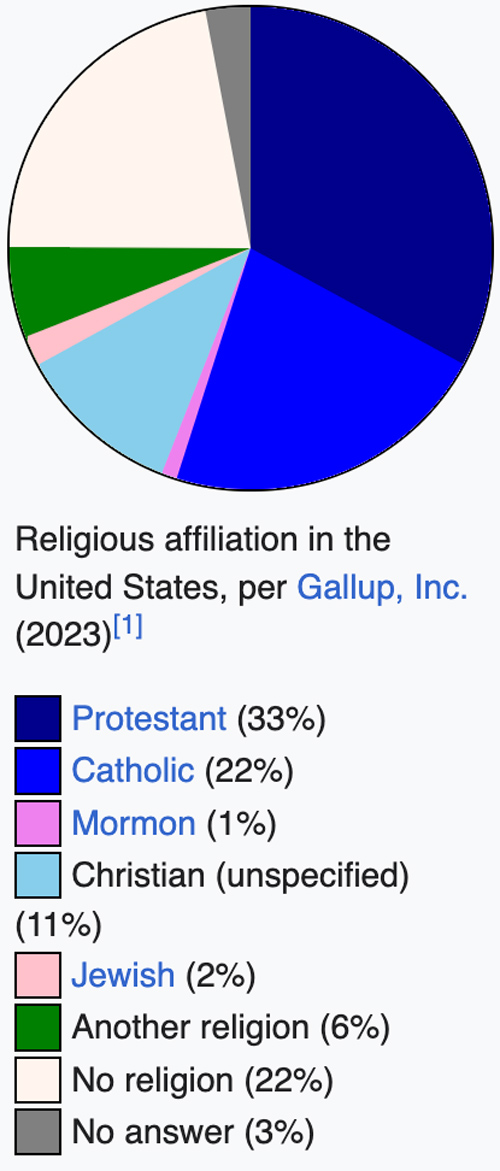Religious Groups in the United States
Overview of Religions Represented in the United States
The United States of America has a wide range of religious diversity ranging from Christianity to Judaism to Buddhism to Neopaganism, as well as several different Native American religions that still survive in the 21st century.
As we know, the English and Germans emigrated from England to North America in pursuit of religious freedom. In 2016, an approximate 74% of adults identified as Christian in America, with the majority of those belonging to a Protestant denomination within the religion.
While the numbers of the United States population regarding Christianity are not overall surprising, what IS surprising is the number of adults with no religious affiliation – at a shocking 22% – equal to the number of Catholics represented in the United States.
How many religions are represented in the United States overall?
According to Lingoda, there are 5 main religions within the United States, comprising 75% of the population (329.5 million):
- Christianity – About 230 million people practice some type of Christianity (Protestantism, Catholicism, Mormon, etc.).
- Judaism – Judaism is practiced by about 7.3 million people in the US.
- Buddhism – About 4.17 million people in the United States identify as Buddhist.
- Islam – In the US, there are around 3.45 million people of the Islamic faith.
- Hinduism – Hinduism is practiced by about 2.5 million people in America.

Chart taken from Wikipedia – Religion in the United States
Religious Minority Groups in the United States
Judaism
After Christianity, Judaism is the next largest religious affiliation in the United States, though this identification is not necessarily indicative of religious beliefs or practices. The Jewish American community has higher household incomes than average, and is one of the best educated religious communities in the United States.
Islam
According to a 2016 Gallup poll, Islam is the third largest religion in the United States by numbers, after Christianity and Judaism, with 0.8% of the population identifying as Muslim. Research indicates that Muslims in the United States are generally more assimilated and prosperous than their counterparts in Europe.
Hinduism
American Hindus have one of the highest rates of educational attainment and household income among all religious communities, and tend to have lower divorce rates. Hindus also have higher acceptance towards homosexuality (71%), which is higher than the general public (62%).
Buddhism
According to the Association of Statisticians of American Religious Bodies newsletter published March 2017, based on data from 2010, Buddhists were the largest minority religion in 186 counties out of the 3143 counties in the country.
Bahá’í Faith
The Bahá’í Faith is a monotheistic religion that originated in Iran in the 19th century. It is based on the belief that all people are part of one human family and that God wants people to live in peace and unity.
Druze Faith
The Druze, who call themselves al-Muwaḥḥidūn, are an Arab esoteric religious group from West Asia who adhere to the Druze faith, an Abrahamic, monotheistic, and syncretic religion whose main tenets assert the unity of God, reincarnation, and the eternity of the soul.
Sikhism
Around the turn of the 20th century, Sikhs started emigrating to the United States in significant numbers to work on farms in California. They were the first community to come from India to the US in large numbers.
Jainism
Adherents of Jainism first arrived in the United States in the 20th century. Jain immigration began in earnest in the late 1960s and continues to the present day.
Taoism
The first Taoists in the United States were immigrants from China during the mid-nineteenth century. They settled mostly in California where the built the first Taoist temples in the country. Currently, the Temple of Original Simplicity is located outside of Boston, Massachusetts.
Native American Religions
Native American ethnic and indigenous faiths historically exhibited much diversity, and are often characterized by animism or panentheism and shamanism. The membership of Native American religions in the 21st century comprises about 9,000 people.
Neopaganism
Neopaganism in the United States is represented by widely different movements and organizations. The largest Neopagan religion is Wicca, followed by Neo-Druidism. Other neopagan movements include Germanic Neopaganism, Celtic Reconstructionist Paganism, Hellenic Polytheistic Reconstructionism, and Semitic neopaganism.
Unitarian Universalism
Unitarian Universalists (UUs) are among the most liberal of all religious denominations in America. The shared creed includes beliefs in inherent dignity, a common search for truth, respect for beliefs of others, compassion, and social action.
*Information taken from Religions in the United States on Wikipedia.
Do any of these religions have a version of the Golden Rule?
The Golden Rule is a tenet by which many Americans use to guide their interactions with everyone in their daily life. It is important to note that most of the world’s major religions (and those of the United States) have a version of this rule.
In fact, at least 75% of the religions practiced in the United States have a version of the Golden Rule including Christianity, Judaism, Islam, Hinduism, Buddhism, and Baha’i Faith.
What about Religious “Nones”?
Religious “Nones” Could be the largest group in America
In an article on NPR, they found that, based on a study done by PEW Research, 28% of those asked what they believe were atheists, “nothing in particular”, but had a belief in a higher power- but identified as “none”.
It was found that those in the “None” group also aren’t very religious. This religious “none” group are becoming a larger segment of the population than Catholics and even Protestants. In fact, in 2007, “Nones” made up only 16% of the population.
Additionally, these Religious Nones, as they’ll be referred to, are less racially diverse. 69% are under the age of fifty. 63% of them are white. Most don’t regularly attend any kind of religious service.
It was also found that Religious Nones are “distinctive”. According to Gregory Smith at Pew, “They are among the most strongly and consistently liberal and Democratic constituencies in the United States.”

Why could this be important?
Given that many of these Religious Nones are younger (under 50), it is very likely that, if they are having families, they are not raising them with any specific kind of religious background or education.
It was noted that the political power of white religious leaders has been a focus of American politics, particularly in the last several years, but their numbers are dwindling while the number of Religious Nones is on the rise.
Regardless of their numbers, Religious Nones are less civically engaged and are challenging to motivate for volunteer opportunities and even encouraging them to vote.
Conclusion
The United States is predominantly Christian, at approximately 230 million people. There are 5 major religions in the United States, including Judaism, Islam, Hinduism and Buddhism, comprising 75% of the population. A growing segment of the population is “Religious Nones” that do not identify with any religion, are atheist or agnostic, or have “nothing in particular”. This “non-religious” group had been, in 2007, only 16% of the population, compared to the 28 a year ago. The world’s major religions have a version of the Golden Rule as part of their faith, with 75% of the religions practiced in America using the Golden Rule as well.